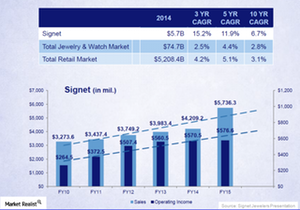Signet Jeweler’s Market Positioning in the Retail Jewelry Industry
Total retail jewelry sales in the US grew at a CAGR of 4.4%, reaching $74.7 billion in 2014. Fine jewelry sales grew at a CAGR of 5%, reaching ~$69 billion.
Nov. 20 2020, Updated 11:04 a.m. ET

Growth challenges for jewelry retailers
According to the US Department of Commerce, between 2010 and 2015, total jewelry and watch sales in the US have grown at a CAGR (compounded annual growth rate) of 4.4%, reaching $74.7 billion in 2014. In the same period, fine jewelry sales have grown at a CAGR of 5%, reaching $69.2 billion in 2014. Total sales at specialty jewelry stores in the US increased by 1.1% YoY (year-over-year) to $33.6 billion.
During this same five-year period, the companies below saw their revenues grew at the following CAGRs:
- Signet Jewelers Limited (SIG)—11.9%
- Tiffany & Company (TIF)—9.4%
- Fossil Group (FOSL)—17.8%
- Pandora AS (PNDZY) (PNDZF) (PNDORA.CO)—27.5%
Signet, Tiffany, and Fossil Group all have exposure in the iShares Russell 1000 Growth ETF (IWF). Together they make up 0.12% of the portfolio holdings of IWF.
Industry challenges
In 2014, the retail jewelry industry (XRT) faced the challenge of price deflation and slow sales. The retail jewelry market is highly dependent on macroeconomic factors, as we saw when the jewelry industry witnessed a sharp decline during the financial crisis of 2008–2009.
We also witnessed price deflation in 2014 in both retail and wholesale jewelry prices. After 1999, this was the first time when dual price deflation hit the jewelry industry, with drops of 3% and 7% in retail and wholesale jewelry prices, respectively. This resulted in lower margins for both retailers and suppliers, and these lower prices could not attract consumers, affecting sales.
Signet’s 2016 goals and competitive strengths
In fiscal 2016, Signet aims to gain a profitable market share through brand differentiation, market segmentation, product cost control, and asset management. Signet’s competitive strengths include the following:
- strong store brands
- an outstanding guest experience
- branded differentiated and exclusive merchandise
- sector leading advertising
- diversified real estate portfolio
- supply chain leadership
Signet also highlights its customer finance programs and financial strength and flexibility as competitive strengths. But what have been the company’s strategic objectives for fiscal 2016? Continue to the next part of this series to find out.
